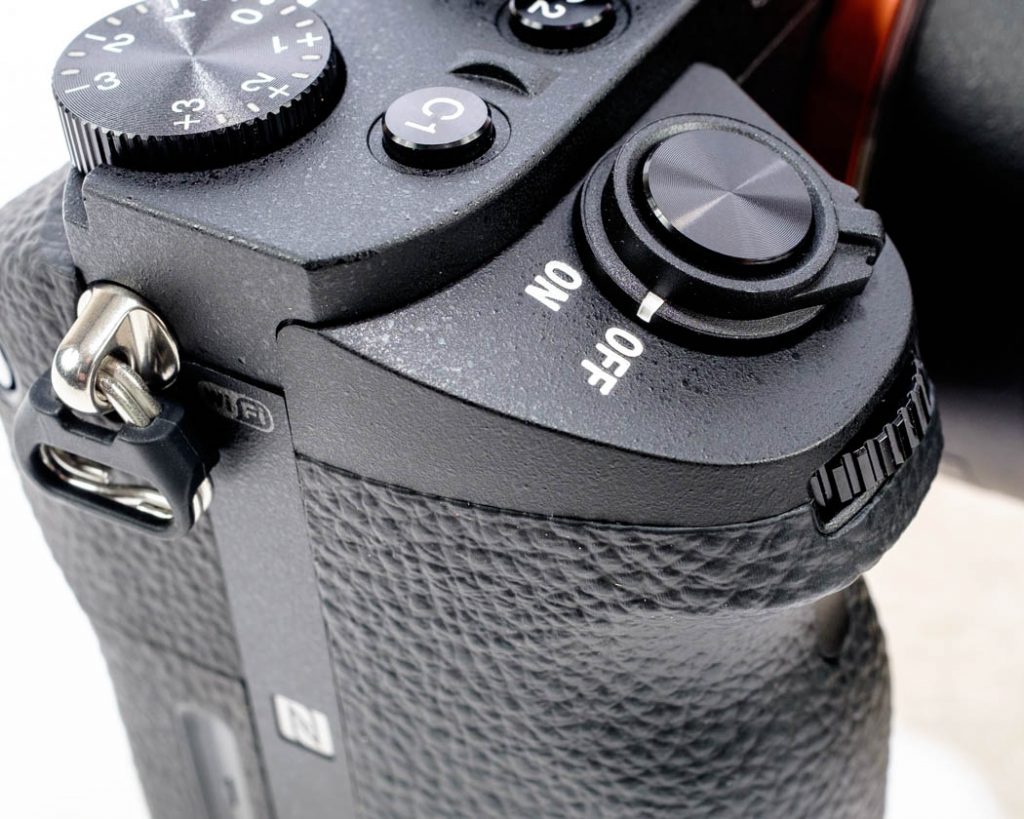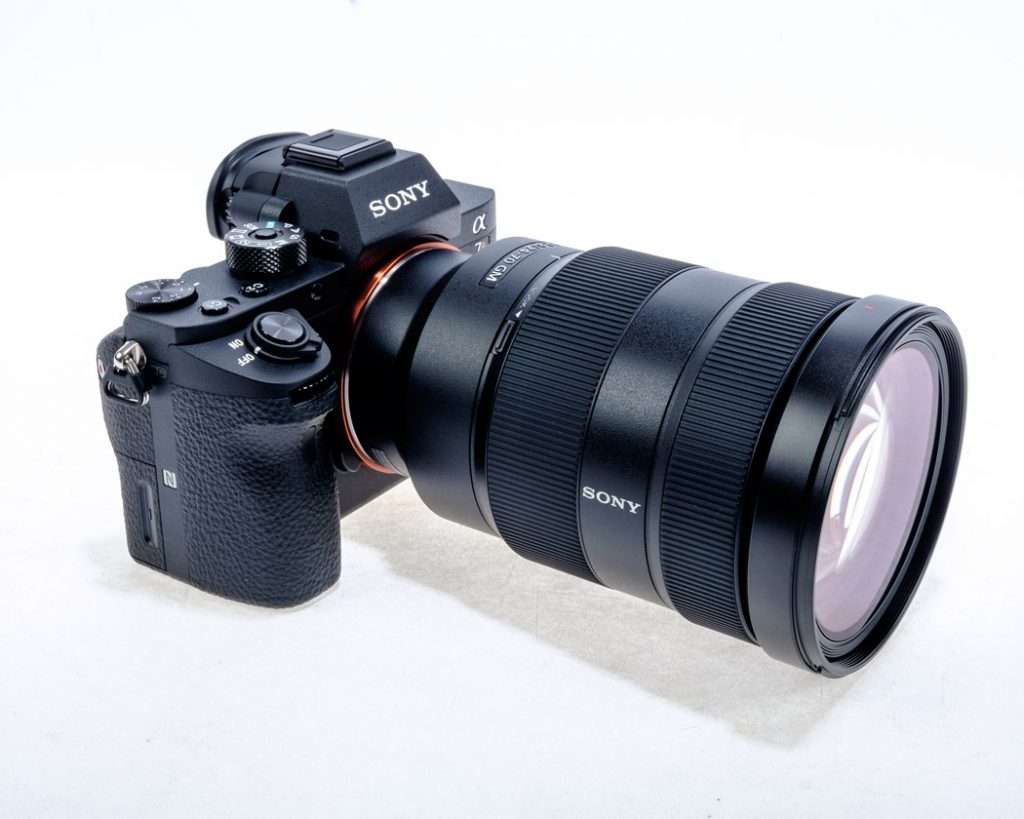No Products in the Cart
 See that angle between the forefinger and the middle finger? That's the comfortable spread of ana adult hand that is grasping something - like a camera body. Anything wider than this starts to hurt.
See that angle between the forefinger and the middle finger? That's the comfortable spread of ana adult hand that is grasping something - like a camera body. Anything wider than this starts to hurt.
 Here's the shutter button support plate of the Sony A7R. The angle of the button matches the angle of the fingers. Thus the camera is comfrotable to shoot. It was not always so with Sony mirror-less bodies - one of the early ones had a shutter button position that was flat on the top of the top plate, and set back far enough that it required an awkward fingergepoken to get it to fire. Your finger fouled the camera strap all the while. Kudos to Sony for correcting their design error - the new one is a dream to shoot.
b. If you are shooting video deliberately, that is a fine thing. And Sony shoots good video. But if you find that you are shooting video inadvertently it is a major pain in the tail gunner's position.
This isn't just a Sony thought - I have several cameras that share the video button with the shutter button, but you need to make it clear to the camera that you actually want to do it...it some cases it is a menu search before you can pass the message, and in others it is a rotating collar or switch.
Here on the Sony it is a dedicated red button just underneath your right thumb, but separated from the other back controls sufficiently that you know when you have triggered it.
Here's the shutter button support plate of the Sony A7R. The angle of the button matches the angle of the fingers. Thus the camera is comfrotable to shoot. It was not always so with Sony mirror-less bodies - one of the early ones had a shutter button position that was flat on the top of the top plate, and set back far enough that it required an awkward fingergepoken to get it to fire. Your finger fouled the camera strap all the while. Kudos to Sony for correcting their design error - the new one is a dream to shoot.
b. If you are shooting video deliberately, that is a fine thing. And Sony shoots good video. But if you find that you are shooting video inadvertently it is a major pain in the tail gunner's position.
This isn't just a Sony thought - I have several cameras that share the video button with the shutter button, but you need to make it clear to the camera that you actually want to do it...it some cases it is a menu search before you can pass the message, and in others it is a rotating collar or switch.
Here on the Sony it is a dedicated red button just underneath your right thumb, but separated from the other back controls sufficiently that you know when you have triggered it.
 This beats one of the cameras I use that has undergone such extensive firmware update improvement that the former " macro " button is now the video button. I am forever hitting it by mistake and taking useless segments of video footage that need to be thrown away. As it is engraved " macro" I will forever be led astray...
c. The hot shoe shuffle. Sony bought up a lot of the design features of konica/minolta when that firm ceased to exist. One of the items was the peculiar hot shoe connector pattern that K/M insisted upon putting on their cameras. Here's an internet image of it:
This beats one of the cameras I use that has undergone such extensive firmware update improvement that the former " macro " button is now the video button. I am forever hitting it by mistake and taking useless segments of video footage that need to be thrown away. As it is engraved " macro" I will forever be led astray...
c. The hot shoe shuffle. Sony bought up a lot of the design features of konica/minolta when that firm ceased to exist. One of the items was the peculiar hot shoe connector pattern that K/M insisted upon putting on their cameras. Here's an internet image of it:
 Quite, quite different from everyone else's configuration and a complete pain in the capacitor for anyone making portable speedlights. The only justification I have heard advanced for it was protection of the contacts - presumably from shrapnel fire - and commericial exclusivity. Sony should have ditched it before they marketed their first digital SLRs...
Quite, quite different from everyone else's configuration and a complete pain in the capacitor for anyone making portable speedlights. The only justification I have heard advanced for it was protection of the contacts - presumably from shrapnel fire - and commericial exclusivity. Sony should have ditched it before they marketed their first digital SLRs...
 Well, that in the past, they have changed the shoe for the newer cameras. They still have their own pattern of connection - see the contact socket bar under the front lip of this hot shoe on the A7R - but the basic shoe can now connect with dumb hot shoe guns or with studio adapters. It's an advance.
Of course, ALL the major makers could have shown advanced intelligence if they had all agreed on one pattern for TTL hot shoe contacts in the first place. They are still proprietorial and higgledy piggledy as it is, but at least you can get a simple make/break out of most of them. I still admire a maker who will put an PC socket on the body somewhere.
d. Clearance space.
Well, that in the past, they have changed the shoe for the newer cameras. They still have their own pattern of connection - see the contact socket bar under the front lip of this hot shoe on the A7R - but the basic shoe can now connect with dumb hot shoe guns or with studio adapters. It's an advance.
Of course, ALL the major makers could have shown advanced intelligence if they had all agreed on one pattern for TTL hot shoe contacts in the first place. They are still proprietorial and higgledy piggledy as it is, but at least you can get a simple make/break out of most of them. I still admire a maker who will put an PC socket on the body somewhere.
d. Clearance space.
 There's a new full-frame lens on a full-frame mirror-less Sony body. The 24-70mm on the a7R. Note the stepped appearance of the lens barrel near to the mount and the fact that it allows plenty of space for he fingers of the photographer aroud the grip. This is not the case with some of the lenses from other makers - if the have a fat barrel near the body there can be blessed little room for the right hand to grip the thing. You find yourself with the cramp or trying to steady the assembly with one or two fingers. Given the fac that the left hand may be twiddling focus or zoom rings and you have a recipe for discomfort, if not shaky pictures.
e. Slick.
There's a new full-frame lens on a full-frame mirror-less Sony body. The 24-70mm on the a7R. Note the stepped appearance of the lens barrel near to the mount and the fact that it allows plenty of space for he fingers of the photographer aroud the grip. This is not the case with some of the lenses from other makers - if the have a fat barrel near the body there can be blessed little room for the right hand to grip the thing. You find yourself with the cramp or trying to steady the assembly with one or two fingers. Given the fac that the left hand may be twiddling focus or zoom rings and you have a recipe for discomfort, if not shaky pictures.
e. Slick.
 Okay, we've seen some cameras that look like alien eggs and when we tried to hold them, they slipped around backwards. And we've seen some cameras that had the ergonomics of a horny toad. No surface could be touched without poking back...
Sony has drawn a careful line between these two extremes - styled the thing so that there is actually some line to it, but left the controls out where your fingers expect to find them. There are no shell traps in the armour. You are not required to do things with four fingers at once to perform a simple task. It can revolve on its strap mounts without making things inaccessible.
It's the classic business of balanced design.
Okay, we've seen some cameras that look like alien eggs and when we tried to hold them, they slipped around backwards. And we've seen some cameras that had the ergonomics of a horny toad. No surface could be touched without poking back...
Sony has drawn a careful line between these two extremes - styled the thing so that there is actually some line to it, but left the controls out where your fingers expect to find them. There are no shell traps in the armour. You are not required to do things with four fingers at once to perform a simple task. It can revolve on its strap mounts without making things inaccessible.
It's the classic business of balanced design.